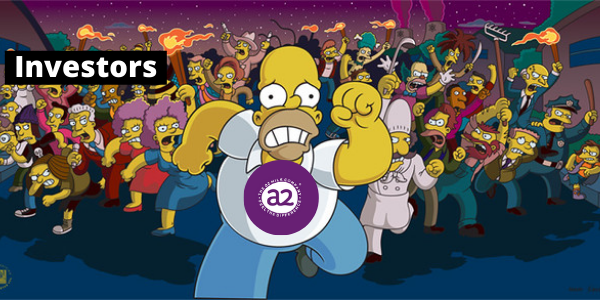Get smarter than your boss in 3 minutes with today's business news.
🍼 a2 Milk are facing a class action
💰 The housing market is getting EVEN tighter
🥤 PepsiCo smashed earnings expectations
Hey hey Flux fam!
We're getting to the pointy end of this week's Flux daily quiz. It's tight at the top of the leaderboard - make sure you play for your chance to win a $100 IKEA voucher.
Good luck!
Here's everything you need to know today - in under 3 minutes.
🍼 a2 Milk are facing a class action
💰 The housing market is getting EVEN tighter
🥤 PepsiCo smashed earnings expectations
For the month of October, we'll be dropping exclusive content to the Flux App, to help you get your head around credit...and smash your financial goals. It's called Flux's Credit Score Restore, and you'll need to download the app so ya don't miss out!

Background: a2 is the Aussie company that makes milk without using the A1 protein. Hence the name. The company's worth nearly $5 billion, largely due to its infant baby formula products.
What happened: Back in August 2020, a2 gave its full-year guidance forecasting great times ahead. But thanks to COVID making it difficult for overseas buyers to make purchases...the company's had to downgrade its earnings. Four times. And shares have plunged 62%.
What else: Here's where it gets a 'lil dicey. The company is now facing a class action led by Slater and Gordon, who reckon a2 were misleading their investors by not giving the full picture back in August.
💡Company guidance is an informal report that a public company gives its shareholders. It shows how much the company expects to earn in the upcoming period.
💡It's essentially the company's best guess at its upcoming earnings, based on information like sales pipelines, market conditions and upcoming spending.
💡But here's the thing: investors base their trading decisions on this company guidance. And, it can potentially trigger share price movements. In a2's case, Slater and Gordon say the company knew a bit more than they led on back in August, and they reckon they've got a case.

Background: We all know house prices have been going up, up and away for a while now. In fact, data at the end of August showed Aussie house prices are more than $100,000 higher than they were last year.
What happened: We also know who we can blame, right? Yup, those pesky low interest rates (which BTW are still at 0.1%) have meant it's never been cheaper to repay a loan. As a result, people are borrowing around six times their income. Yikes.
What else: Rising house prices have put Australia in a housing affordability crisis. So, the banking regulator (aka APRA) has increased the serviceability buffer to 3%. This means someone who could borrow $1 million under the old buffer could now only borrow about $950,000.
💡When you go to take out a home loan, one of the most important criteria that banks look at is your serviceability - aka whether you can meet the repayments of the loan.
💡The banks are also required to chuck on a serviceability buffer. This is a percentage 'buffer' that gets added to your loan repayments to see if you could still make the loan repayments if interest rates increase.
💡This means if your home loan rate is 3%, banks will need to assess whether you can make repayments at a 6% interest rate (3% home loan rate + 3% serviceability buffer = 6%). As the buffer goes up, borrowing capacity goes down. APRA is hoping this'll cool off house prices.
.gif)
Background: PepsiCo is the fizzy and salty goods company behind products like Doritos, Smith's Chips, Mountain Dew and of course, Pepsi and Pepsi Max.
What happened: Pepsi's long been seen as the less-cool younger bro of Coke...but it still has a huge market share of carbonated soft drinks. We're talkin' nearly 26% in the US. And the whole company is worth a whopping US$208 billion.
What else: Now, PepsiCo's revenue has smashed analysts' expectations despite global supply chain issues and product price hikes. The company's net sales rose a whopping 11.6% to US$20.19 billion.
💡Generally, when a company increases its prices, it causes customers to buy less product (it's called price elasticity). So, brands try to hide the price increase...Remember when Cadbury cut its choccie blocks by a fifth, and only reduced prices by 20 cents?
💡Other companies like Pepsi are attacking the issue straight on with flat out price hikes.
💡And, although it seems like Pepsi's wearing the Survivor immunity necklace...its customers are just really loyal. They'll buy the products no matter what (aka price inelastic!).
Sign up for Flux and join 100,000 members of the Flux family